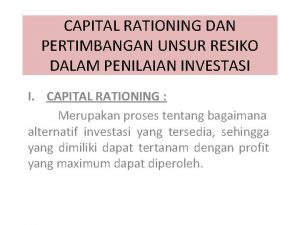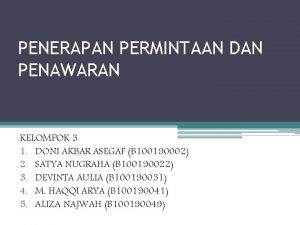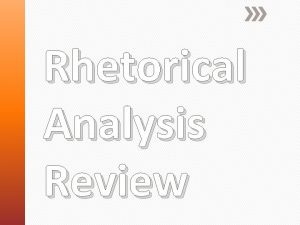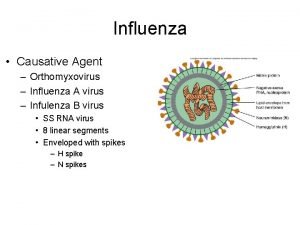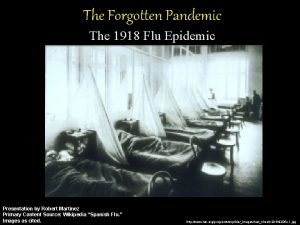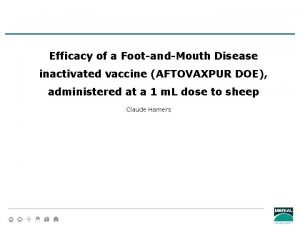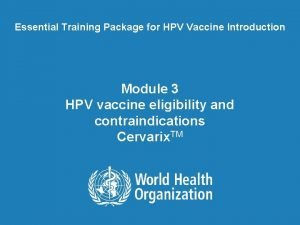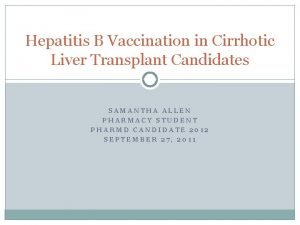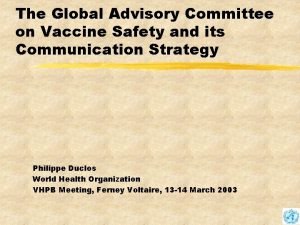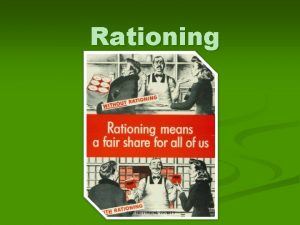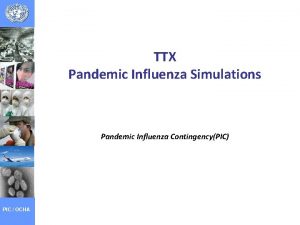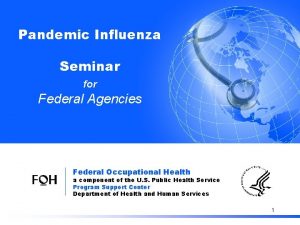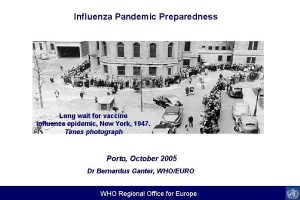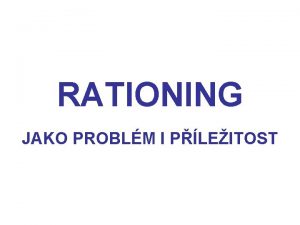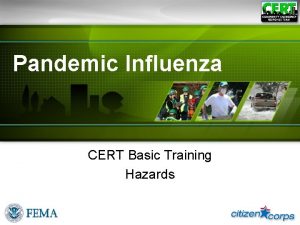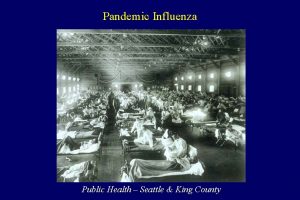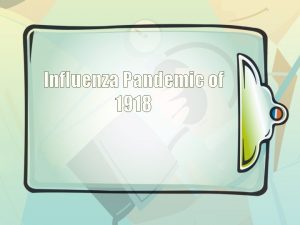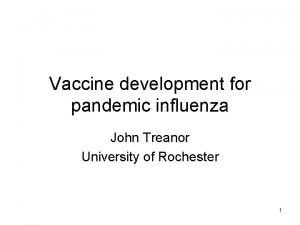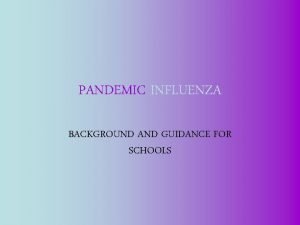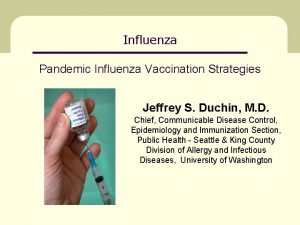Rationing of Influenza Vaccine During a Pandemic An





























- Slides: 29

Rationing of Influenza Vaccine During a Pandemic: An Ethical Analyses Richard Kent Zimmerman, MD, MPH Department of Family Medicine & Clinical Epidemiology

1918 Influenza Pandemic Dr. Victor Vaughn, acting surgeon general of the army, receives urgent orders to proceed to Camp Devens. Once there, what Vaughn sees changes his life forever: – "I saw hundreds of young stalwart men in uniform coming into the wards of the hospital. Every bed was full, yet others crowded in. The faces wore a bluish cast; a cough brought up the blood-stained sputum. In the morning, the dead bodies are stacked about the morgue like cordwood. " On that day at Camp Devens, 63 men died from influenza. www. pbs. org/wgbh/amex/influenza/sfeature

3

Introduction Framework considers: – Epidemiology of influenza – Suffering due to complications – Differing pandemic mortality patterns – The historical differences between pandemics – Efficacy of inactivated influenza vaccines – Competing ethical theories of utilitarianism and egalitarianism – Winslow’s Triage and Justice

Complications of Influenza Primary Complications of influenza: – Secondary bacterial pneumonia – Worsening of chronic respiratory and cardiac diseases

Complications of Influenza and Suffering Due to Pneumonia In the 1918 pandemic, an acute adult respiratory distress syndrome (ARDS) presentation was common – Likely due to an inflammatory reaction including a cytokine storm – Similar to the pathogenesis seen in the recent, human deaths due to H 5 N 1

Pandemic Mortality Patterns Mortality patterns vary by pandemic – Fatality rate by age from influenza in 1957 and 1968 pandemics was “U” shaped with an estimated 69, 800 and 33, 800 U. S. deaths, respectively Majority of deaths were in the elderly and among those with high risk conditions – 1918 pandemic revealed a “W” pattern with a high rate of deaths also among young adults aged 2040 years

Inactivated Influenza Vaccines Conventional inactivated vaccines may be less effective against pandemic viruses, require more quantity of antigen and perhaps two doses for everyone – Efficacy may vary modestly by age, being lower in young children and the elderly Head-to-head comparisons are often lacking for pandemic influenza vaccines and the differences between ages for inter-pandemic vaccine are modest

Inactivated Influenza Vaccine Efficacy When Inter-Pandemic Antigen Match is Good by Age with ILI / Laboratory Confirmed ILI 70 -90% 56 -76% 44 -67% 50 -60% 30 -40%

Competing Ethical Approaches: Utilitarianism versus Egalitarianism Too little vaccine for the population Perhaps can manufacture 5 million doses per month 4 months after identification of pandemic How distribute limited supply? Gerald Winslow in Triage and Justice – Contrasts the strengths and weaknesses of utilitarianism and egalitarianism – Offers a framework which is useful for considering the rationing of influenza vaccine in light of a pandemic

Utilitarianism and Utilitarian Principles for Rationing Looks at the rightness or wrongness of a decision based on its consequences and resultant strategies either maximize happiness or minimize unpleasantness Commonly used in triage situations and has the benefit of weighing perceived consequences to rank options – e. g. , prioritize those most likely to be able to fight again in wartime triage Once highly popular in Western thought

Utilitarian principles First 4 based on Winslow’s work as applied to rationing, include priority to those: 1. In whom treatment has the highest success 2. Who are most useful 3. Who require proportionally small amounts of resources 4. Who have greatest social worth 5. Better quality of life 6. Younger Age

Utilitarianism: those with the highest probability of success Seems logical Likely to include adolescents through middle age groups as long as they do not have severely immunocompromising conditions Efficacy may be somewhat higher in those who have healthy habits and good nutrition and are compliant Such factors may also be related to social worth and socioeconomic status The greater the number of such factors that are considered, the greater the concern for injustice – (Winslow, Triage & Justice)

Utilitarianism: those who are most useful Logical as critical personnel are needed in the vaccine manufacturing process and in healthcare institutions – can assist great number ill – JAMA 2006; 295: 554 -6 What about other industries for society’s well being? – How many are critical? Where do draw the line? Arguments for prioritization of health care workers (HCWs): – Risk of transmission to patients and other HCWs – Decreasing absenteeism of essential HCWs during outbreaks – Protect HCWs who have conditions that place them at risk for influenza complications – Protect high risk household and personal contacts of HCWs

Utilitarianism: those who require less resources Seems logical Data on partial, inactivated vaccine during interpandemic periods for healthy, young & middle age adults show a generally good immune response – however, studies are small and inter-pandemic – Perception that I did not get “my” share of full dose – Partial doses may be less effective if high risk conditions Conserve resources by ring vaccination – Limit vaccination to those in close contact with initial cases – Problematic with influenza as viral shedding starts before symptoms

Utilitarianism: Quality of Life Criterion Quality of life assessments can be somewhat arbitrary Judging other’s quality of life based on observable issues often differs from the patient’s own experience of their lives – Physician assessments differ from patients J Gen Int Med 1986; 1: 373 -9 – Assessments often differ between physicians J Am Geriatric Soc 1985; 33: 344 -52 Can discriminate against several groups, with people rating the quality of life of people of dissimilar race, gender or SES as lower than their own

Utilitarianism: Age Criteria Objective, simple, appears equitable Limitations: – Although age is objective, that does not mean that it is appropriate (e. g. weight) – 2 -year mortality from pneumonia in the elderly is related to underlying medical illnesses but not age in one study Lancet 1993; 342: 30 -33 – Vaccination is immunogenic in most elderly persons and immunogenicity is driven more by underlying medical conditions than by age

Egalitarianism and Egalitarian Principles for Rationing Based on the maintenance and restoration of equality Proposes that people have essentially equal rights to have their needs met Justice consists of distribution according to need All lives are counted as equals

Egalitarian Principles Based on Winslow’s work as applied to rationing, include priority to those who: 1. 2. 3. 4. Are the medically neediest Are the generally neediest Come first Are selected by chance 5. Also, medical benefit (not Winslow’s)

Egalitarianism: those who are the medically neediest Essence of the egalitarian approach to social justice Used in the US 2004 influenza vaccine shortage Gives priority to the most ill – Inefficient by a productivity standard Applied to the most recent pandemics, the old, young children and those with underlying disease would be priorities – The number prioritized would be quite large and further prioritization using other principles would be needed

Egalitarianism: those who are the most helpless (generally neediest) Based in part on the principle of compensatory justice Prioritizes children, the handicapped and those deprived of advantages by past social injustice These criteria may be difficult to apply, particularly during the chaotic periods of a pandemic

Egalitarianism: those who come first Based on equality of opportunity Some equate this with random process However, those with good connections and better access to information and transportation are more likely to come first – These factors are related to social status and SES – Potential for injustice and favoritism

Egalitarianism: those selected by chance Totally impartial Life of each person is given the same weight as any other Removes concerns that humans are ill-equipped to decide whom should live when all cannot Removes judgments about relative values between people Criticized for lack of rational prioritization and being an easy method to avoid hard decisions Use by British in a polio vaccine scarcity – Hinds in Lifeboat Ethics 1976 p 38 -39.

Egalitarianism: Medical Benefit Criterion Specifies that those who lack a reasonable likelihood of receiving significant benefit from treatment are excluded from treatment on medical grounds Gives equal regards for all persons Consistent with policy recommendations to withhold cancer screening in those without a sufficient life expectancy to realize a benefit Excludes severely immunocompromised within weeks of death – takes 2 weeks for vaccine to work in many immunocompetent persons

Both Utilitarian and Egalitarian Principles Several principles seem to straddle the utilitarian/egalitarian divide – Usefulness (e. g. vaccine manufacturers, health care workers) – Reducing transmission – “Fair innings”

Reducing Transmission School-aged children play a role in the transmission of influenza – have been proposed as a priority group for vaccination However, concerns about the historic data limitations – data on amount of actual transmission during pandemics due to children in various settings (school, home, etc) – contagiousness of influenza in other groups – not led to widespread adoption of this strategy Extrapolating transmission patterns based on social structures of decades past is problematic

Applying Multiple Ethical Principle to Vaccine Rationing Multiple principles will need to be applied in many rationing situations due to the complexities of the decisions – British Ministry of Health: lottery system when polio vaccine was scarce Hinds in Lifeboat Ethics 1976 p 38 -39 – For a scarce number of artificial hearts, Winslow supports medical neediness and random selection qualified if needed by medical success, conservation and “first-come”

My Evaluative Summary of the Ethical Principles for Rationing Influenza Vaccine manufacturers would be a top priority, followed by Health Care Workers Then apply a medical benefit criterion liberally For a “U” shaped mortality curve – apply medical neediness then select by random lottery For a “W” shaped mortality curve – lottery would follow medical benefit The epidemiology and mortality patterns of the particular pandemic would supply important scientific facts to guide the application of ethical principles

Limitations Epidemiology and mortality patterns of the next pandemic, including the specifics of the role of children in transmission in the 21 st century are not known and would affect conclusions This analysis does not account for widespread use of live attenuated influenza vaccine, particularly among children (only licensed for 5 -49 year-olds) Competing ethical theories clash – I may be accused of favoring the egalitarian perspective
 Influenza vaccine dosage chart 2019-2020
Influenza vaccine dosage chart 2019-2020 Rationing function of prices
Rationing function of prices Rationing device definition economics
Rationing device definition economics Apa itu capital rationing
Apa itu capital rationing Rationing function of prices
Rationing function of prices Soft capital rationing
Soft capital rationing Permintaan kelompok
Permintaan kelompok The black market
The black market Pandemic tabletop exercise template
Pandemic tabletop exercise template Mathalicious pandemic answer key
Mathalicious pandemic answer key Covid 19 pandemic summary
Covid 19 pandemic summary Who pip framework
Who pip framework Interpandemic period
Interpandemic period Influenza virus replication
Influenza virus replication The great influenza rhetorical analysis
The great influenza rhetorical analysis The causative agent of influenza
The causative agent of influenza Is influenza a airborne disease
Is influenza a airborne disease Low pathogenic avian influenza
Low pathogenic avian influenza Olfactory mucosa
Olfactory mucosa Rimantidina
Rimantidina Influenza
Influenza Influenza ww1
Influenza ww1 Modulo termico materozza
Modulo termico materozza Stomach flu vs influenza
Stomach flu vs influenza Honeywell aerospace engineer salary
Honeywell aerospace engineer salary Aftovaxpur vaccine
Aftovaxpur vaccine Hpv vaccine schedule adults
Hpv vaccine schedule adults Poliomyelitis
Poliomyelitis Hep b series for adults
Hep b series for adults Global vaccine safety network
Global vaccine safety network



